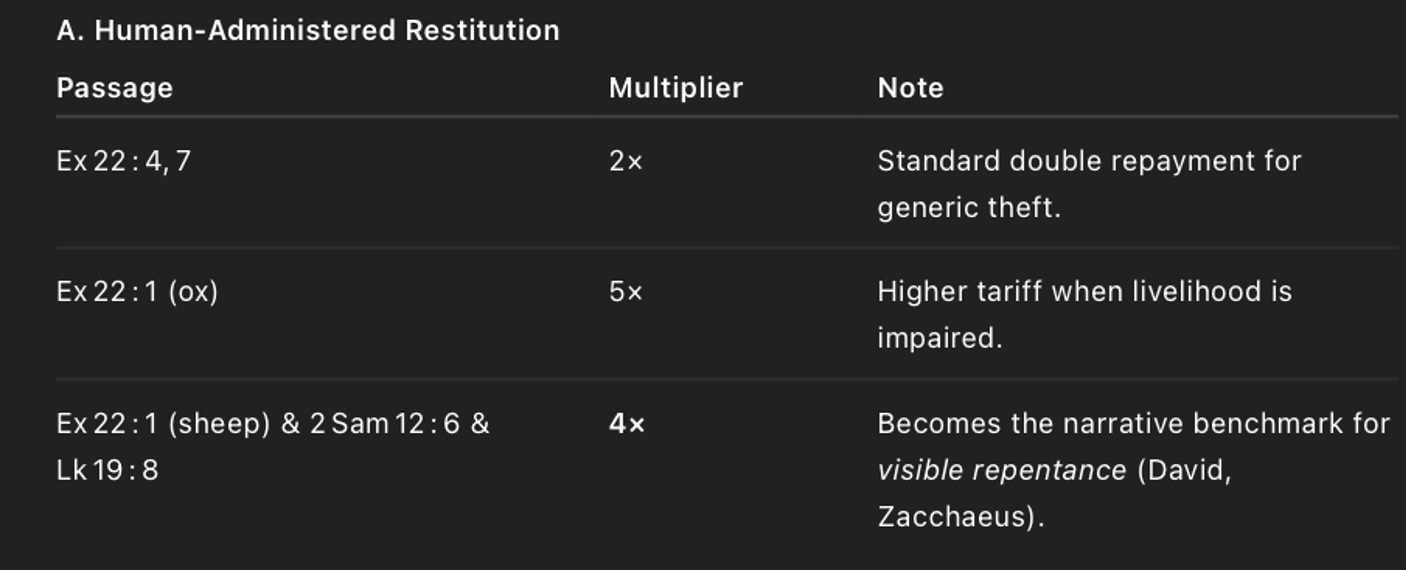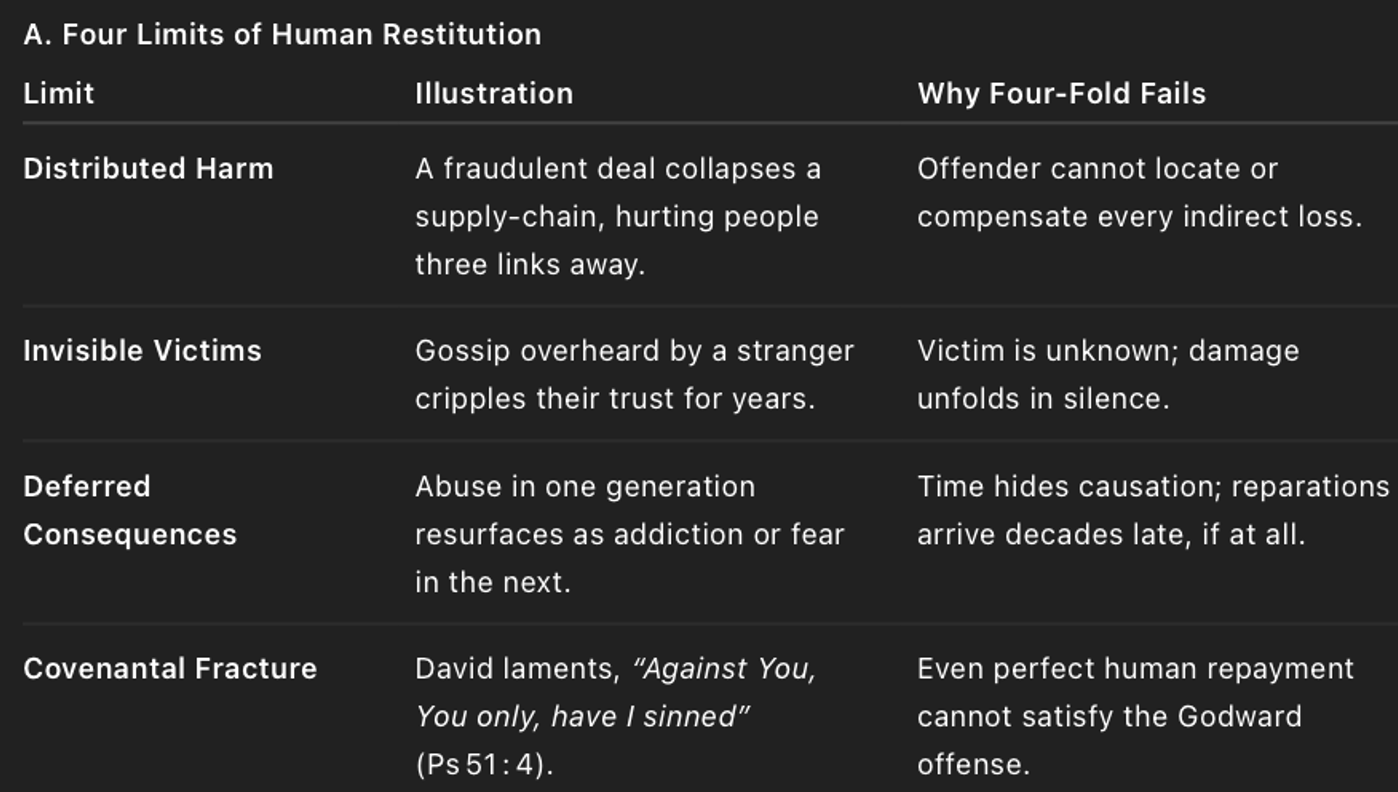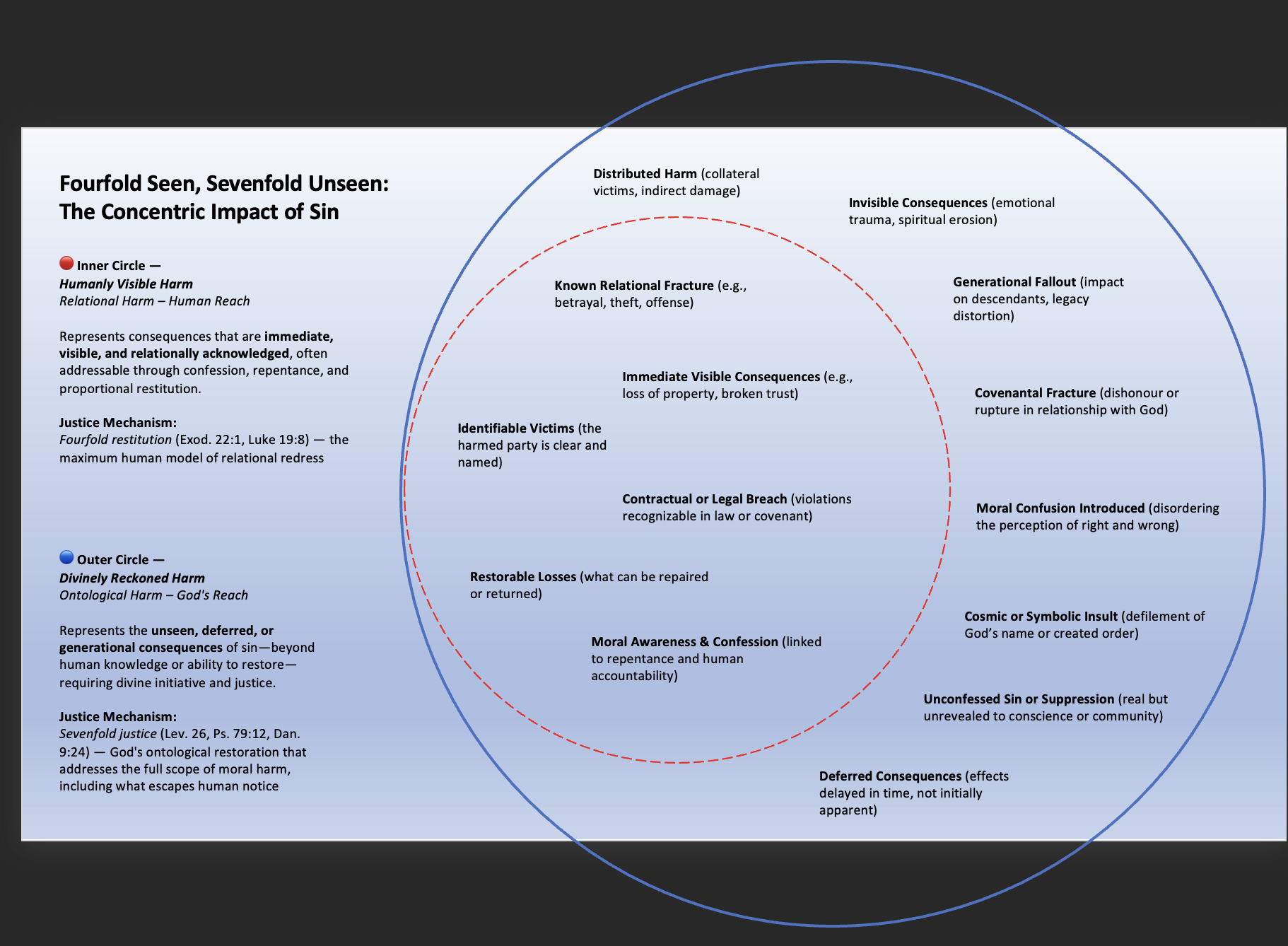Scripture reveals a patterned distinction between human and divine responses to moral harm: fourfold restoration reflects the visible, relational justice expected of human agents in covenantal contexts; sevenfold restoration represents God’s ontological reckoning with all harm—seen and unseen, direct and distributed, personal and cosmic—through his sovereign justice and grace.
A crooked tax‑collector once vowed to repay his victims four times what he had taken (Luke 19: 8). Centuries earlier, Israel’s civil code required the same multiplier for a stolen sheep, but five‑fold for a stolen ox and double for other goods (Ex 22: 1, 4). And yet, when God Himself speaks of setting things right, a different number echoes through Scripture—seven‑fold. He shields Cain with a seven‑fold warning (Gen 4 : 15), disciplines Israel seven‑fold for covenant breach (Lev 26: 18 ff.), and finally seals history with a prophetic seventy‑times‑seven timetable (Dan 9:24‑27).
Why do these numbers differ? Is one merely legal trivia and the other sacred symbolism—or do they mark two distinct horizons of justice?
This essay argues that they do. Four‑fold restoration belongs to the domain of relational accountability—the damage a wrong‑doer can see and repair. Seven‑fold restoration belongs to the domain of ontological equity—harm so distributed, deferred, or hidden that only God can address it. Together they form a concentric pattern:
To trace that pattern we will: (1) Map every major restitution ratio in Scripture and show how agency and scope line up; (2) Connect these layers to two kinds of moral confrontation: elentic (the personal unveiling of guilt) and epidectic (God’s orchestrated disclosure of truth); (3) Show why even the deepest contrition cannot cover generational or unseen harm, and how the cross functions as God’s seven‑fold remedy; (4) Close with the promise that God’s judgments will one day be fully inspectable—even to the point that the redeemed will “judge angels” (1 Cor 6: 3) by examining, not executing, His verdicts.
Justice, then, is not flat. It comes in layers—some we can enact; many we must entrust to the Judge who sees what we cannot.
Before we build theory, we need raw data. Scripture assigns specific multipliers when wrongs are righted. Grouped by agent, the pattern begins to speak for itself.

Four‑fold is not the only legal ratio, but it is the one that surfaces whenever Scripture tells a story of confessed wrongdoing. The text itself elevates 4× as the exemplary signal of relational restitution. In every case, the agent is aware of the damage, the harm is concrete and personal, and the remedy is visible and measurable. It reflects what the offender can reasonably see, admit, and repay.
It is, in this sense, relationally bounded justice—ethical, proximate, and covenantal.

In every case the seven theme is tied to God’s own action, not human courts. Even Proverbs 6: 31— “he shall restore seven‑fold”—is idiomatic: the thief may lose everything he owns, not literally repay seven times. The number marks totality, not a payable sum. By contrast, the sevenfold pattern appears in domains where:
Whether in the divine protection of Cain (Gen 4), the covenant curses upon Israel (Lev 26), or the prophetic time-table of Daniel (70×7), the sevenfold structure signals a justice that:
Even when a sevenfold ratio appears in relation to a human thief (Prov 6:31), most scholars understand it as idiomatic—a way of saying “he will lose everything.” It marks the limits of human restitution and the entrance into divine recompense.
These recurring numeric distinctions are not ornamental—they are signposts of scale and jurisdiction. They suggest that:
The fourfold pattern is a ceiling on what humans can see and restore. The sevenfold pattern is a floor beneath which God ensures that nothing collapses unreckoned.
These observations lay the groundwork for the next section, where we explore how people are confronted with their guilt (elentic exposure) and why God alone orchestrates the larger reckoning (epidectic disclosure).
II. Two Kinds of Confrontation: Elentic Exposure & Epidectic Disclosure
Bridging note. We have seen that four‑fold and seven‑fold restitutions fall into different hands. Why? Because the way a wrongdoer meets the truth—how justice reaches them—also falls into two distinct modes.
Elentic (from Gk. elenchos, “conviction”) is the personal unveiling of guilt—the moment a conscience is cornered— moral exposure— the noetic undraping of a volitional agent’s internal posture. It is not merely intellectual acknowledgment of wrongdoing, but an existential confrontation with truth. In this moment, a person:
Snapshot: Nathan’s parable tears off David’s royal self‑deception; tears flow, a four‑fold sentence is pronounced (2 Sam 12).
Characteristics
Other examples include: Zacchaeus, convicted and volunteering fourfold restitution (Luke 19). The Ninevites, responding to Jonah’s warning. When the elentic encounter is received with humility, it often leads to visible acts of relational restoration—including, in the narrative pattern, fourfold restitution. These acts function as moral tokens of alignment.
But elentic confrontation can also be resisted. In such cases, exposure still occurs—but its fruit is suppression, not repentance (Rom 1:18–21).
Gloss: Elentic = subjective conviction; God’s spotlight inside the agent.
If elentic justice is what the human agent experiences, epidectic confrontation is what God initiates.
The word epidictic (from Greek epideixis) refers to display or disclosure—the moment in which truth is unveiled not just for the sake of the agent, but as part of God’s sovereign moral orchestration. Epidectic moments are:
These moments are not always perceived as such by the agent. Cain was confronted—but responded with deflection. Pharaoh was confronted repeatedly—but hardened himself. Judas was confronted—but withdrew into despair.
Nevertheless, God remains just, because the epidictic event is always sufficient to reveal the agent’s noetic posture—whether through exposure, judgment, or invitation.
In other words: epidictic confrontation guarantees access; elentic response reveals alignment.
Snapshot: Cain hears God’s warning and sees the protective mark—seven‑fold consequences are declared (Gen 4: 15).
Characteristics
Gloss: Epidectic = divine disclosure; God’s scoreboard above the agent.
These dimensions are not sequential but concurrent:
These axes are not about degrees of guilt, but about depths of revelation—and the domains in which justice must unfold.
And importantly:
With the mechanics of confrontation in place, we can now ask: Even when elentic repentance is genuine, why is four‑fold still inadequate? Section III answers by tracing the burden of unreckoned harm.
Human restitution, however sincere, cannot reach all the consequences of sin. The fourfold pattern—where the wrongdoer visibly acknowledges and restores—is righteous, necessary, and commanded. But it is not sufficient. Not because it is insincere, but because the moral terrain of harm is far larger than human awareness can account for.
This is where the distinction between relational justice and ontological justice becomes unavoidable. Fourfold restoration may patch what is seen; sevenfold justice is required to address what is not.
Even the most heartfelt apology and the largest restitution cheque can reach only so far. Four‑fold justice is righteous, but it is radius‑bound—limited to the circle of harm the offender can see. Scripture and experience alike testify that sin radiates far beyond that circle.

Even the most contrite agent can only restore what they know they’ve broken. But sin never stays where it’s put. It spreads—into the hearts of others, into relationships, institutions, generations, and futures.
1. Distributed Harm
What about those harmed indirectly?
Fourfold restitution can’t find or fix every ripple. It’s bounded by proximity and perception.
2. Invisible Victims
What about the people you didn’t know were watching? Or suffering?
Fourfold justice can’t reach the unseen listeners, the forgotten bystanders, the collateral hearts.
3. Deferred Consequences
What about outcomes you can’t predict or measure?
Human justice has temporal blindness. It accounts for what is now visible, not what is yet unfolding.
Even in David’s case—though he repents and receives forgiveness—the cascading harm through his household and kingdom illustrates what no fourfold restoration can reach. The sevenfold burden was borne by God alone.
4. Covenantal Fracture
What about sin against God? Even when restitution is made to people, the relational fracture with God—His holiness, His order, His design—remains untouched. Psalm 51:4 cries, “Against You, You only, have I sinned…” David understood that his sin reached higher than its human consequences.
In jurisprudence, when statutes cannot fully repair harm, courts appeal to equity—a realm of remedies shaped by conscience rather than code. Scripture anticipates this distinction. Four‑fold restitution functions like statutory law: precise, enforceable. Seven‑fold restoration operates like equity: reaching injuries no rulebook can price. But unlike human equity, God’s seven‑fold justice is omniscient and flawless.
The diagram below conceptualises the discussion so far.

This diagram visualizes the concentric scope of sin’s impact—from visible, relational harm to unseen, ontological fracture.
The inner circle represents what humans can observe, confess, and restore through moral awareness and relational accountability.
The outer circle represents consequences that ripple beyond human reach—affecting generations, covenantal order, and divine honour—requiring God’s own justice to redress.
Inner Circle – Fourfold Justice (Human Reach):
🔴 Relational and visible harm—acknowledged injuries, legal breaches, and restorable losses.
Governed by proportional restitution
(Exod. 22:1; Luke 19:8).
Outer Circle – Sevenfold Justice (Divine Reach):
🔵 Distributed, deferred, and invisible harm—emotional, generational, covenantal, and cosmic.
Addressed only through divine initiative
(Lev. 26; Ps. 79:12; Dan. 9:24).
Beyond the Boundary – Off-Chart Ramifications:
⚠️ Some consequences exceed our moral radar and restorative capacity.
They lie off the chart—felt but unnamed, generationally embedded or cosmically symbolic.
These are not forgotten; they are reserved for God’s eschatological justice.
Where human justice reaches its limit, divine justice begins. While fourfold restitution restores balance in the seen and relational realm, sevenfold justice addresses the incalculable—those cascading harms, generational traumas, unseen injuries, and cosmic insults that no human court can weigh. In Scripture, seven does not merely signify numerical quantity but symbolic totality—completion, sufficiency, and ontological resolution. It is God's number for what is fully dealt with—nothing omitted, nothing overlooked.
Where humans repair what they see, God restores what was invisible: the ripple of consequences beyond the immediate, the buried trauma, the spiritual insult to His name, and the unraveling of moral coherence in creation. Sevenfold justice is not excess—it is exact. It is what righteousness requires when reckoning exceeds human awareness or ability.
Key Texts Revisited:
Principle: Sevenfold justice is not punitive arithmetic; it is ontological equity. It represents God's prerogative to rectify the irreparable—to address not just the debt, but the spiritual erosion caused by it. Where fourfold restitution answers visible injustice, sevenfold justice answers the unreckoned—that which escaped confession, escaped awareness, escaped courtrooms—but never escaped the divine gaze.
Sevenfold is not metaphor. It is God’s structural response to ontological dislocation. Divine justice is not merely distributive—it is reweaving. It does not merely restore what was taken; it restores the fabric in which it was taken.
Having seen humanity’s ceiling and God’s horizon, we are ready to ask how these two layers converge. Section IV turns to the cross, where seven‑fold restoration meets four‑fold repentance in a single, decisive act of atonement.
If four‑fold restitution marks the limit of human justice and seven‑fold restitution marks the fulness of divine justice, the cross is where the two axes intersect. At Calvary, God does not merely forgive; He repairs reality at the depth no human act can reach.

These are not relational tokens. They are ontological transactions—real acts that:
This is sevenfold restoration, not metaphorically but structurally. Only God can see the full extent of the damage, and only God can reconcile it. Only God sees every fracture; only God can mend every thread. The cross enacts the seven‑fold principle—comprehensive, cosmic, final.
The entire Levitical system—blood, atonement, scapegoats, sabbaths—was prophetic scaffolding pointing to this ontological resolution:
These patterns prepared Israel to recognize that when restoration came in fullness, it would:
This is epidictic restoration—ordained, orchestrated, and fulfilled by God Himself, without collaboration or supplementation from man.
Zacchaeus’s pledge, David’s repentance, modern restitution—these remain essential, but they echo the cross; they never augment it. Our visible acts:
Four‑fold repentance is the public amen to God’s seven‑fold restoration.
IV.F. The Role of Human Response: Participation Without Pretension
Fourfold restitution still matters—it is the visible echo of the internal elentic response to God's confrontation. But it cannot:
Our repentance is real—but not redemptive. Our contrition is essential—but not causative.
We respond within the structure that only God can construct.
Zacchaeus’s fourfold pledge was not a condition of salvation—it was its public sign. David’s confession came only after God sent Nathan—it was elicited by God’s epidictic confrontation. These were relational enactments of an ontological mercy they could neither trigger nor complete.
With the convergent architecture clear, we turn finally to how believers live amid unfinished stories, trusting a justice that will soon be open for all to see.
Even after repentance, restitution, and faith in the cross, every honest heart senses loose threads: sorrows no apology can erase, damages no payment can calculate, mysteries no human can solve. Scripture neither ignores that ache nor leaves it to sentiment. It points us to a final act of justice that is both transparent and total.
Paul writes, “Do you not know that we will judge angels?” (1 Cor 6: 3). The promise is not that the redeemed will wield a gavel, but that they will be allowed to inspect God’s judgments—even those concerning fallen angels. Revelation echoes the theme: “The books were opened” (Rev 20: 12) and heaven cries, “True and just are Your judgments” (Rev 16: 7; 19: 2).
Paul’s wording does not mean that the redeemed will pass independent sentence. The Greek word krinō, translated “judge” (1 Corinthians 6:3), can also mean evaluate, discern, or confirm—as it does when Paul says, “Judge for yourselves what I say” (1 Corinthians 10:15), or “Why do you not judge for yourselves what is right?” (Luke 12:57). In 1 Corinthians 6, Paul’s point is about moral and spiritual competence—that those who will one day be entrusted to inspect and affirm God’s higher judgments should be capable of resolving trivial disputes now. In that future unveiling, the redeemed will not arbitrate independently but will understand and approve the righteous judgments of God— “the books were opened” (Revelation 20:12), and “we shall know fully” (1 Corinthians 13:12). Every sevenfold rectification will be seen to be “true and just” (Revelation 16:7).
Take‑away: Nothing will remain hidden. Seven‑fold justice is not only comprehensive—it will be reviewable. God invites inspection because His equity will withstand it.

Both parties can move forward—one freed from crushing guilt, the other from corrosive bitterness—because God Himself carries the unreachable balance.
This distinction frees both:
We are called to pursue fourfold restoration where we can—but also to entrust to God the justice we cannot see. Divine equity is not reactive; it is architectonic. It repairs reality from the top down, not merely from the moment out.
Seven‑fold justice means that every fracture has an appointment with the Healer‑Judge. It transforms mystery from threat into promise.
When Jesus promised that not one sparrow falls without the Father’s knowledge, He wasn’t only addressing comfort—He was invoking divine attentiveness. Every fracture, every ripple of harm, every ontological dislocation is seen. And more than seen—it is being restored.
Whether in this age or the one to come, sevenfold justice ensures that nothing unravelled by sin remains forever unbound.
Justice is layered, mercy is deeper than memory, and the last word on every wound—yours or another’s—belongs to the Judge whose books will balance in full view of a reconciled universe.
In light of this layered justice: we live, as it were, within a cosmic restoration project that we did not initiate—but are lovingly invited to join.
The heart knows what law cannot measure. The soul remembers fractures that no courtroom can repair. And still, Scripture speaks—not only of forgiveness, but of full restoration. Not only of mercy, but of sevenfold justice. The fourfold return of relational equity anchors our moral obligation. But it is the sevenfold reach of divine justice that satisfies the mystery: the generational harm, the invisible trauma, the ripple effects no one saw but God.
In this age, we restore what we can. We repent, reconcile, and release. But the ledger is not ours to settle. The books are already written. And in the age to come, those books will be opened—not so we can amend God’s justice, but so we can witness it. Not so we may pass sentence, but so we may see—and say— “He has done all things well.”
So we live now in trust—not in the silence of injustice, but in the certainty that no injustice is final. The cross bore our debt. The resurrection assures our hope. And the Day will come when the Judge opens every page, and no wound—whether inflicted or endured—will be unhealed, unreconciled, or unreckoned.
In the end, justice is not a number. But the numbers in Scripture—fourfold, sevenfold, seventy times seven—speak a deeper grammar. They are not formulas, but fractals of a moral architecture: signs that God's justice extends beyond what we can restore, perceive, or even imagine.
We have seen that:
And beyond these patterns lies a cross—where the ontological restoration of all things was not only initiated but guaranteed.
We live now between these layers. We confess what we can, restore what we must, and entrust the rest to the Judge who sees what we cannot. In doing so, we refuse despair. We declare that God's justice is not deferred silence, but active restoration, unfolding in time and revealed in eternity.
When all things are made new, we will not only rejoice in what has been forgiven. We will marvel at what has been healed—often without our knowing, always without ledgered demand, and entirely in righteousness.
In that day, every knee shall bow—not because justice was forced, but because it was finally seen.
The sevenfold structure of divine justice reveals that God does not merely respond to harm—He exposes, confronts, and restores what human systems cannot reach. Every motive, every concealed consequence, every unseen victim is drawn into view. This justice is not symbolic. It is real. It is covenantal. And it is ultimately redemptive. But its very completeness casts into sharp relief the failure of all human substitutes.
What, then, becomes of justice when these categories are forgotten—when personhood is obscured, when restitution is displaced by performance, and when systems preserve the appearance of justice while denying its moral reality?
To that question we address in Appendix E8.
Related articles include Appendix E2 (Theodicy) and Moral Taxonomy and Deontic Modal Unit .
